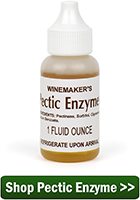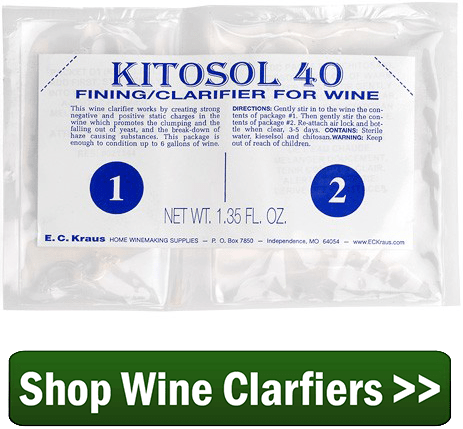 I am having some trouble getting some of my fruit wine to clear. The berry wines clear right away (black raspberry, elderberry, blueberry, raspberry, current) but some of the other fruit wines stay cloudy (apple, peach, pear, dogwood). Is there something different I should be doing with these wines to make them clear better?
I am having some trouble getting some of my fruit wine to clear. The berry wines clear right away (black raspberry, elderberry, blueberry, raspberry, current) but some of the other fruit wines stay cloudy (apple, peach, pear, dogwood). Is there something different I should be doing with these wines to make them clear better?
Name: Charlene
State: New York
—–
Hello Charlene,
It might be a pectin haze that’s making your wine cloudy. Some fruits have more pectin in them than others. Pectin is the gel that holds the fruit’s fiber together. If the pectin is not completely broken down during the fermentation you can end up with what known as a pectin haze in your wine. This sounds like what is giving you a cloudy wine.
During the fermentation the yeast will produce pectic enzymes to breakdown the pectin cells. You may have also added pectic enzyme directly to the batch per your wine recipe. With most fruits this is sufficient, but even then you can sometimes end up with a pectin haze with the particular fruit wines you mentioned.
Apple, peach and pear all have significant levels of pectin, more so than most other fruits. The dogwood I’m not sure about. If you did not add pectic enzyme to your wine recipe, then most certainly a pectin haze is the issue at hand. But, even if you did add pectic enzyme, this is still what I suspect is going on because of the specific wines that are cloudy. Pectic enzyme is that important.
As for what you can do now…
Whether or not you have added pectic enzyme to your wine must, you can add more now, however it may take some time for the wine to clear… sometimes months. Of course, this is assuming you have not bottled the wine already. If you have, then that ship has already sailed, so to speak. You could decant the wine; treat the wine; and then re-bottle, however I would not do it if it were my wine, simply for the fact that this type of cloudiness dose not affect the flavor at all only appearance. Live-and-learn, and move on.
Even at that, one thing you could do for future reference is to take a bottle of the suspect wine; add it to a quart Mason jar, or similar; and treat it with a teaspoon of pectic enzyme. This would be an extremely strong dose, so if a pectin haze is the issue at hand, you should see it respond to the addition of pectic enzyme by clearing in a matter of days if not hours. This will let you know if you have found the problem in the form of a pectin haze for future reference and give you a little piece of mind.
As a home winemaker, pectin haze issues should always be in the back of one’s mind. It’s something that doesn’t happen all that often, but when it does, it can be very aggravating.  Keep a particularly close eye when fermenting fruits high in pectin and always use pectic enzyme when fermenting fresh fruits.
Keep a particularly close eye when fermenting fruits high in pectin and always use pectic enzyme when fermenting fresh fruits.
Happy Winemaking,
Ed Kraus
—–
Ed Kraus is a 3rd generation home brewer/winemaker and has been an owner of E. C. Kraus since 1999. He has been helping individuals make better wine and beer for over 25 years.

Ed, I read once that you shouldn’t add pectic enzyme to warm must. I usually wait to let the must cool down. Do you recommend this?
Larry, regarding temperature and pectic enzyme, with temperatures starting at about 125°F it will start to denature, which simply means become permanently inactive or ineffective.
Is there a guide on how much to add?
Jeff, I would just follow the directions listed on the product for dosage. Our pectic enzyme is liquid and the dosage is 1/8 teaspoon for each gallon of wine. If you did not add it in the beginning, I would add a double dose.
After reading some of your articles related to the wine faults related to sediments after bottling, I have got some of the weak point that is causing the problem in my wine. But I want to asking you that the sediments would be seen within few days when my final wine is allowed to freeze after bottling. However, It lacks the sediments at the bottom of the bottle when it is kept at room temperature but takes time to come with sediment in the bottle. What is the main reason behind this? I am so much worried that i cant solve this since few months. Hoping for quick response.
Bijendra, it sounds like you are experiencing tartaric acid precipitation. I would take a look at the article posted below for more information on how to treat the wine.
Maintaining Temperature Stability
http://eckraus.com/wine-making-stabilization/